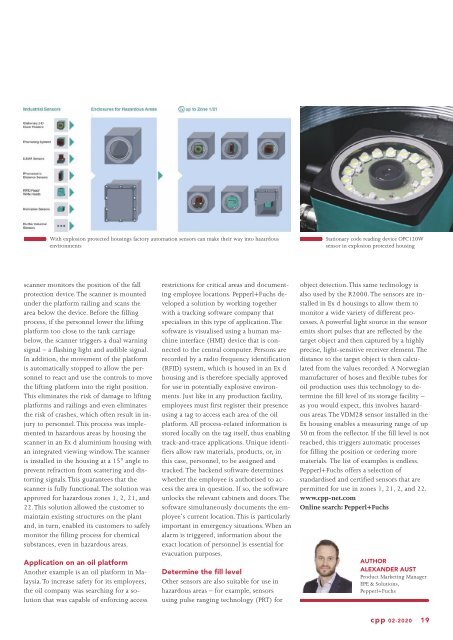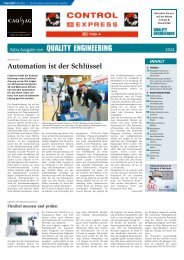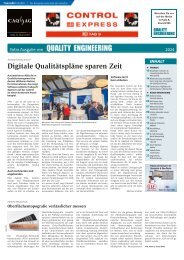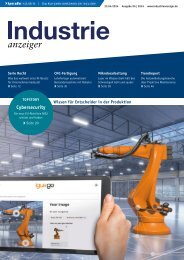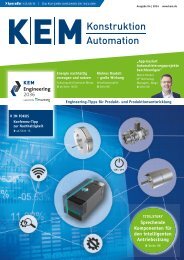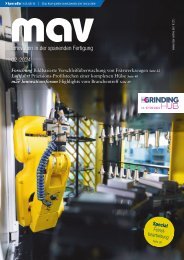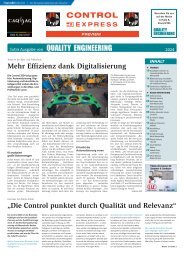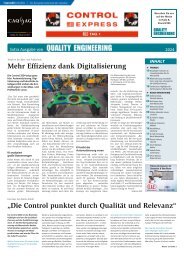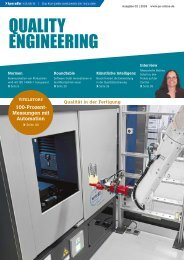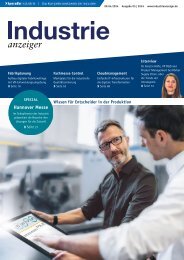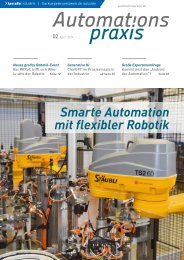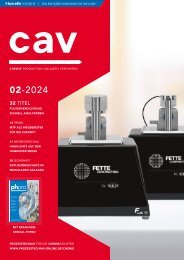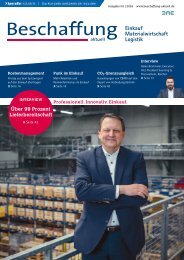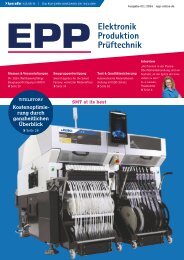cpp – Process technology for the chemical industry 02.2020
The journal cpp - Process technology for the chemical industry reports about processes, plants, apparatus and components for the chemical and pharmaceutical industry. Further topics are IT technologies, industry 4.0, digital production, MSR and automation technology and process analysis technology. The content spectrum is rounded off by explosion protection, plant safety, occupational health and safety, maintenance, site management and energy management.
The journal cpp - Process technology for the chemical industry reports about processes, plants, apparatus and components for the chemical and pharmaceutical industry. Further topics are IT technologies, industry 4.0, digital production, MSR and automation technology and process analysis technology. The content spectrum is rounded off by explosion protection, plant safety, occupational health and safety, maintenance, site management and energy management.
You also want an ePaper? Increase the reach of your titles
YUMPU automatically turns print PDFs into web optimized ePapers that Google loves.
With explosion protected housings factory automation sensors can make <strong>the</strong>ir way into hazardous<br />
environments<br />
Stationary code reading device OPC120W<br />
sensor in explosion protected housing<br />
scanner monitors <strong>the</strong> position of <strong>the</strong> fall<br />
protection device. The scanner is mounted<br />
under <strong>the</strong> plat<strong>for</strong>m railing and scans <strong>the</strong><br />
area below <strong>the</strong> device. Be<strong>for</strong>e <strong>the</strong> filling<br />
process, if <strong>the</strong> personnel lower <strong>the</strong> lifting<br />
plat<strong>for</strong>m too close to <strong>the</strong> tank carriage<br />
below, <strong>the</strong> scanner triggers a dual warning<br />
signal <strong>–</strong> a flashing light and audible signal.<br />
In addition, <strong>the</strong> movement of <strong>the</strong> plat<strong>for</strong>m<br />
is automatically stopped to allow <strong>the</strong> personnel<br />
to react and use <strong>the</strong> controls to move<br />
<strong>the</strong> lifting plat<strong>for</strong>m into <strong>the</strong> right position.<br />
This eliminates <strong>the</strong> risk of damage to lifting<br />
plat<strong>for</strong>ms and railings and even eliminates<br />
<strong>the</strong> risk of crashes, which often result in injury<br />
to personnel. This process was implemented<br />
in hazardous areas by housing <strong>the</strong><br />
scanner in an Ex d aluminium housing with<br />
an integrated viewing window. The scanner<br />
is installed in <strong>the</strong> housing at a 15° angle to<br />
prevent refraction from scattering and distorting<br />
signals. This guarantees that <strong>the</strong><br />
scanner is fully functional. The solution was<br />
approved <strong>for</strong> hazardous zones 1, 2, 21, and<br />
22. This solution allowed <strong>the</strong> customer to<br />
maintain existing structures on <strong>the</strong> plant<br />
and, in turn, enabled its customers to safely<br />
monitor <strong>the</strong> filling process <strong>for</strong> <strong>chemical</strong><br />
substances, even in hazardous areas.<br />
Application on an oil plat<strong>for</strong>m<br />
Ano<strong>the</strong>r example is an oil plat<strong>for</strong>m in Malaysia.<br />
To increase safety <strong>for</strong> its employees,<br />
<strong>the</strong> oil company was searching <strong>for</strong> a so -<br />
lution that was capable of en<strong>for</strong>cing access<br />
restrictions <strong>for</strong> critical areas and documenting<br />
employee locations. Pepperl+Fuchs developed<br />
a solution by working toge<strong>the</strong>r<br />
with a tracking software company that<br />
specialises in this type of application. The<br />
software is visualised using a human machine<br />
interface (HMI) device that is connected<br />
to <strong>the</strong> central computer. Persons are<br />
recorded by a radio frequency identification<br />
(RFID) system, which is housed in an Ex d<br />
housing and is <strong>the</strong>re<strong>for</strong>e specially approved<br />
<strong>for</strong> use in potentially explosive environments.<br />
Just like in any production facility,<br />
employees must first register <strong>the</strong>ir presence<br />
using a tag to access each area of <strong>the</strong> oil<br />
plat<strong>for</strong>m. All process-related in<strong>for</strong>mation is<br />
stored locally on <strong>the</strong> tag itself, thus enabling<br />
track-and-trace applications. Unique identifiers<br />
allow raw materials, products, or, in<br />
this case, personnel, to be assigned and<br />
tracked. The backend software determines<br />
whe<strong>the</strong>r <strong>the</strong> employee is authorised to access<br />
<strong>the</strong> area in question. If so, <strong>the</strong> software<br />
unlocks <strong>the</strong> relevant cabinets and doors. The<br />
software simultaneously documents <strong>the</strong> employee‘s<br />
current location. This is particularly<br />
important in emergency situations. When an<br />
alarm is triggered, in<strong>for</strong>mation about <strong>the</strong><br />
exact location of personnel is essential <strong>for</strong><br />
evacuation purposes.<br />
Determine <strong>the</strong> fill level<br />
O<strong>the</strong>r sensors are also suitable <strong>for</strong> use in<br />
hazardous areas <strong>–</strong> <strong>for</strong> example, sensors<br />
using pulse ranging <strong>technology</strong> (PRT) <strong>for</strong><br />
object detection. This same <strong>technology</strong> is<br />
also used by <strong>the</strong> R2000. The sensors are installed<br />
in Ex d housings to allow <strong>the</strong>m to<br />
monitor a wide variety of different processes.<br />
A powerful light source in <strong>the</strong> sensor<br />
emits short pulses that are reflected by <strong>the</strong><br />
target object and <strong>the</strong>n captured by a highly<br />
precise, light-sensitive receiver element. The<br />
distance to <strong>the</strong> target object is <strong>the</strong>n calculated<br />
from <strong>the</strong> values recorded. A Norwegian<br />
manufacturer of hoses and flexible tubes <strong>for</strong><br />
oil production uses this <strong>technology</strong> to de -<br />
termine <strong>the</strong> fill level of its storage facility <strong>–</strong><br />
as you would expect, this involves hazardous<br />
areas. The VDM28 sensor installed in <strong>the</strong><br />
Ex housing enables a measuring range of up<br />
50 m from <strong>the</strong> reflector. If <strong>the</strong> fill level is not<br />
reached, this triggers automatic processes<br />
<strong>for</strong> filling <strong>the</strong> position or ordering more<br />
materials. The list of examples is endless.<br />
Pepperl+Fuchs offers a selection of<br />
standardised and certified sensors that are<br />
permitted <strong>for</strong> use in zones 1, 21, 2, and 22.<br />
www.<strong>cpp</strong>-net.com<br />
Online search: Pepperl+Fuchs<br />
AUTHOR:<br />
ALEXANDER AUST<br />
Product Marketing Manager<br />
EPE & Solutions,<br />
Pepperl+Fuchs<br />
<strong>cpp</strong> 02-2020 19


